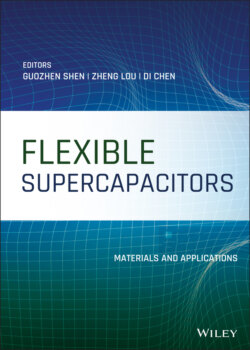Читать книгу Flexible Supercapacitors - Группа авторов - Страница 37
2.2.3.1 Cellular Structure
ОглавлениеIn nature, many animals like the North American elk or bird have a cellular bone that provides large deformations under attacking or during flying. Inspired by the biological materials, cellular structure is introduced to stretchable SCs because it can resist a broad spectrum of deformations including bending and stretching. A typical work has been reported by Peng's group, as shown in Figure 2.11a–c [40]. Figure 2.11a displayed the optical images of the stretchable cellular CNT film under increasing strain. The cellular CNT film was synthesized as follows: first, a paper mask with exposed cellular pattern was employed to coat a cellular catalyst in the silica wafer, then the CNT film was prepared by CVD on patterned catalyst covered silica wafer, after pressing and peeling off, the cellular CNT film was finally obtained, which could be stretched by 150%. Afterwards, a sandwiched stretchable SCs with two cellular CNT films separated by PVA/H3PO4 gel electrolyte was assembled. The electrochemical performance was also carried out in Figure 2.11b. The fabricated stretchable SCs showed a specific capacitance of 42.4 F g−1 with the electrode thickness of 38.3 μm. The identical CV curves for 0–140% strain demonstrated the excellent stability of the cellular stretchable SCs. The high specific capacitances can be reserved 98.3% after stretching by 140% for 3000 cycles. Figure 2.11c depicted a watch strap powered by the stretchable SCs that accommodate the deformation of the arm size, suggesting a novel class of possible designs for 3D stretchable SCs.
Figure 2.11 (a) Optical images of the stretchable cellular CNT film under increasing strain. (b) CV curves under stretching. (c) Photographs of the “watch strap” powered by cellular MSC array.
Source: Reproduced with permission [40]. © 2016, The Royal Society of Chemistry.
(d) Optical images of honeycomb 4 × 4 MSC arrays under different stretching state. (e) Capacitance retention versus elongation (the inset figure is the CV curves for 0–150% elongation, respectively). (f) LED powered by a honeycomb MSC device under stretching.
Source: Reproduced with permission [73]. © 2016, American Chemical Society.
Another type of 3D stretchable SCs are fabricated by embedding several flexible MSCs devices into a cellular form thus make the MSCs stretchable. This assembled method provides a general integration way, not only in the area of energy storage, as well as energy harvester like solar cell, wireless charging units and wearable electronics such as sensors, detectors. For example, Pu et al. introduced a stretchable cellular PDMS support for flexible 4*4 MSC arrays, as shown in Figure 2.11d–f [73]. The mechanical performance of honeycomb MSC array was displayed by the optical images of the devices with strain ranging from 0% to 275%. The mechanical performance of the devices also simulated by finite element analysis (FEA). From the CV curves, the specific capacitance of single SWCNT based MSC was calculated to 1.86 F cm−3 at scan rate of 0.05 V S−1, the corresponding volumetric capacitance of the 4*4 MSC arrays was 0.15 F cm−3. Figure 2.11e showed the capacitance retention versus strains, it is very clearly seen that the capacitance of the MSC arrays kept unchanged when applied strains varying from 0 to 150%, which was also suggested by the invariable CV curves (Inset). A commercial LED lighting test driven by a honeycomb MSC devices that attach to a Nike wrist band under stretching was provided in Figure 2.11f, demonstrating the mechanical stability of the cellular MSC arrays at different stretching state. Noticeably, the voltage and current can be easily controlled through the intrinsic configuration of the cellular structure (different series or parallel interconnection modes), this also make the cellular stretchable SCs competitive among various types of stretchable SCs.
